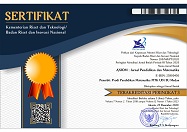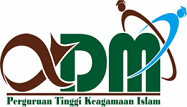ETHNOMATHEMATICS: THE CONSTRUCTION OF PEDATI GEDE CIREBON AND THE POTENTIAL OF ITS INTEGRATION IN MATHEMATICS LEARNING
Abstract
Keywords
Full Text:
PDFReferences
Abi, A. M. (2016). Integrasi etnomatematika dalam kurikulum matematika sekolah. JPMI (Jurnal Pendidikan Matematika Indonesia), 1(1), 1–6. https://doi.org/10.26737/jpmi.v1i1.75
Aminah, M., Kusumah, Y. S., Suryadi, D., & Sumarmo, U. (2018). The effect of metacognitive teaching and mathematical prior knowledge on mathematical logical thinking ability and self-regulated learning. International Journal of Instruction, 11(3), 45–62. https://doi.org/10.12973/iji.2018.1134a
Anggara, B. (2019). Desain pembelajaran matematika pada konsep dasar peluang berbasis kearifan lokal Indramayu. JNPM (Jurnal Nasional Pendidikan Matematika), 3(2), 223–237. https://doi.org/10.33603/jnpm.v3i2.2377
Arwanto, A. (2017). Eksplorasi etnomatematika batik trusmi cirebon untuk mengungkap nilai filosofi dan konsep matematis. Phenomenon : Jurnal Pendidikan MIPA, 7(1), 40–49. https://doi.org/10.21580/phen.2017.7.1.1493
Athar, G. A. (2012). Pengembangan pembelajaran matematika dengan pendekatan pendidikan matematika realistik (pmr) berbasis budaya cerita rakyat melayu riau pada kelas 3 sekolah dasar [Thesis,Universitas Negeri Yogyakarta]. http://eprints.uny.ac.id/id/eprint/35047
Bahri, S. (2011). Identifikasi jenis dan berat kendaraan melalui jembatan timbang. Jurnal Inersia, 2(2), 1–5. https://doi.org/10.33369/ijts.2.2.1-5
Barton, B. (2007). Making sense of ethnomathematics: ethnomathematics is making sense. In Stepping Stones for the 21st Century (pp. 225–255). Australia: Brill. https://doi.org/10.1163/9789087901509_014
D’Ambrosio, U. (2001). What is ethnomathematics, and how can it help children in schools? Teaching Children Mathematics, 7(6), 308–310. https://doi.org/10.5951/tcm.7.6.0308
Faqih, A., Nurdiawan, O., & Setiawan, A. (2021). Pengembangan media pembelajaran multimedia interaktif alat masak tradisional berbasis etnomatematika. Mosharafa: Jurnal Pendidikan Matematika, 10(2), 301–310. https://doi.org/10.31980/mosharafa.v10i2.876
Fatonah, S., & Assingkily, M. S. (2020). Quo vadis materi pesawat sederhana dalam pembelajaran ipa sekolah dasar di era disrupsi. Edu Sains Jurnal Pendidikan Sains & Matematika, 8(1), 46–60. https://doi.org/10.23971/eds.v8i1.1899
Fitriyah, A. T., & Syafi, M. (2022). Etnomatematika pada bale lumbung sasak. Mosharafa: Jurnal Pendidikan Matematika, 11(1), 1–12. https://doi.org/10.31980/mosharafa.v11i1.1050
Gerdes, P. (1994). Reflections on ethnomathematics. For the Learning of Mathematics, 14(2), 19–22. https://eric.ed.gov/?id=EJ502146
Hardiani, N., & Putrawangsa, S. (2019). Etnomatematika: tradisi pengukuran masyarakat suku sasak dan potensi pengintegrasiannya dalam pembelajaran matematika. AKSIOMA: Jurnal Program Studi Pendidikan Matematika, 8(1), 159–174. https://doi.org/10.24127/ajpm.v8i1.1814
Karimah, N. I., Kusuma, D. A., & Noto, M. S. (2021). Etnomatematika: analisis sistem geometri pada motif batik trusmi cirebon. Euclid, 8(1), 16. https://doi.org/10.33603/e.v8i1.3690
Kusmawan, W., Turmudi, T., Juandi, D., & Sugilar, H. (2018). Meningkatkan kemampuan berpikir kreatif dan pemecahan masalah matematis siswa madrasah aliyah. Jurnal Analisa, 4(1), 188–198. https://doi.org/10.15575/ja.v4i1.2839
Ma’mun, T. N., & Safari, R. A. O. (2018). Cariyos walangsungsang: transliterasi dan terjemahan. Jakarta: Perpustakaan Nasional Republik Indonesia. https://library.unissula.ac.id/opac/index.php?p=show_detail&id=59893
Marsigit, Condromukti, R., Setiana, D. S., & Hardiarti, S. (2014). Pengembangan pembelajaran matematika berbasis etnomatematika. Prosiding Seminar Nasional Etnomatnesia, 20–38. https://jurnal.ustjogja.ac.id/index.php/etnomatnesia/article/view/2291
Nansha, H., Sachari, A., & Sabana, S. (2021). Symbolic meaning of pedati gede pekalangan cirebon. International Seminar on Innovation in Arts, Resonance of Technology and Science, 2(1), 1–9. https://conference.isi-ska.ac.id/index.php/iicacs/article/view/45
Noto, M. S., Firmasari, S., & Fatchurrohman, M. (2018). Etnomatematika pada sumur purbakala desa kaliwadas cirebon dan kaitannya dengan pembelajaran matematika di sekolah. Jurnal Riset Pendidikan Matematika, 5(2), 201–210. https://doi.org/10.21831/jrpm.v5i2.15714
Rosa, M., Orey, D. C., Wiilfredo V, A., & Gavarrete, M. El. (2016). Current and future perspectives of ethnomathematics as a program. Springer Nature. https://doi.org/10.1007/978-3-319-30120-4
Sucipto, T. (2010). Eksistensi keraton do cirebon kajian persepsi masyarakat terhadap keraton-keraton di cirebon. Patanjala : Jurnal Penelitian Sejarah Dan Budaya, 2(3), 472. https://doi.org/10.30959/patanjala.v2i3.240
Suranny, L. E. (2017). Moda transportasi tradisional jawa. Jurnal Penelitian Arkeologi Papua Dan Papua Barat, 8(2), 217–231. https://doi.org/10.24832/papua.v8i2.189
Susilawati, W., Suryadi, D., & Dahlan, J. A. (2021). The improvement of mathematical spatial visualization ability of student through cognitive conflict. International Electronic Journal of Mathematics Education, 12(2), 155–166. https://doi.org/10.29333/iejme/607
Wulandari, D. A., Kusumah, Y. S., & Priatna, N. (2022). Eksplorasi nilai filosofis dan konseptual matematis pada bagunan keraton kasepuhan cirebon ditinjau dari aspek etnomatematika. Jurnal Cendekia : Jurnal Pendidikan Matematika, 6(3), 2536–2551. https://doi.org/10.31004/cendekia.v6i3.1421
Zulfah, S. (2018). Islamisasi di cirebon: peran dan pengaruh walangsungsang perspektif naskah carios walangsungsang. Jurnal Tamaddun : Jurnal Sejarah Dan Kebudayaan Islam, 6(1), 172–201. https://doi.org/10.24235/tamaddun.v6i1.3270
DOI: http://dx.doi.org/10.30821/axiom.v12i2.17763
Refbacks
- There are currently no refbacks.
Copyright (c) 2023 Imam Saparudin, Benny Anggara, Atikah Nuril Huda, Indri Zakiah Awaliyah, Maman Tasman

This work is licensed under a Creative Commons Attribution-ShareAlike 4.0 International License.
p-ISSN: 2087-8249 | e-ISSN: 2580-0450
Indexed by:
AXIOM : Jurnal Pendidikan dan Matematika is licensed under a Creative Commons Attribution-ShareAlike 4.0 International License.











